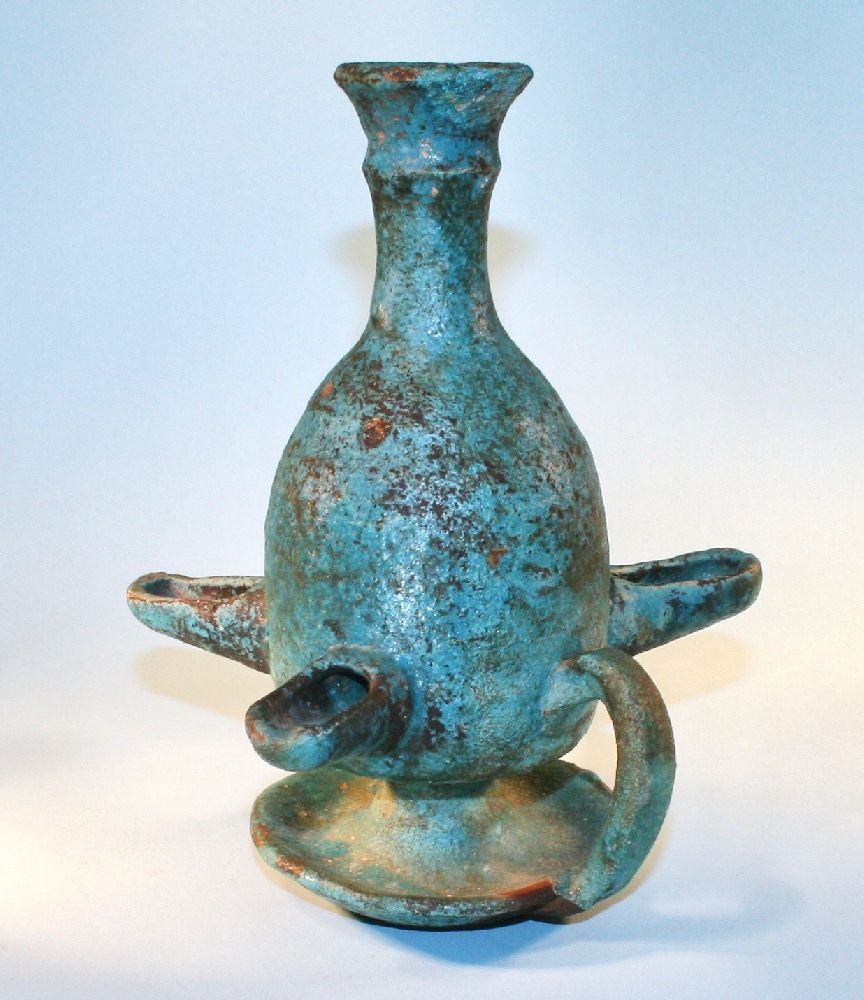

Title: Antique Ceramic Persian Glazed Stoneware Oil Lamp
Shipping: $29.00
Artist: N/A
Period: 19th Century
History: N/A
Origin: Middle East > Iran
Condition: Excellent
Item Date: 1830 to 1930
Item ID: 33
Beautifully Turquoise blue design. This looks to be an ancient artifact ceramic Persian oil lamp. The oil lamp has three Openings. The style Has all the elements of Persian or middle eastern Stoneware. An unusual form of Ceramic oil lamp with three spouts with side handle. It could be as old as the third century. What a great look on the bookshelf Or near a ceramic collection. Each collectible is hunted down & chosen to invoke individual curiosity. The object is selected for its’ beauty, rarity, material, design, quality & cultural significance with the goal to find its original historical lost value. Every day, new discoveries are carefully curated & archived by, BusaccaGallery.com. We invite you to look closely at the treasure trove of archived stories & videos we personally researched & hand-picked, with the focus to identify, educate, assess, & inform, so we can consult all our patrons properly.
Link: https://en.wikipedia.org/wiki/Persian_pottery
Persian pottery or Iranian pottery refers to the pottery works made by the artists of Persia (Iran) and its history goes back to early Neolithic Age (7th millennium BCE). Shortly after Susa was first settled 6000 years ago, its inhabitants erected a temple on a monumental platform that rose over the flat surrounding landscape. The exceptional nature of the site is still recognizable today in the artistry of the ceramic vessels that were placed as offerings in a thousand or more graves near the base of the temple platform. Nearly two thousand pots were recovered from the cemetery and now, most of them now are located in the Louvre; one such vessel is the Bushel with ibex motifs. The vessels found are eloquent testimony to the artistic and technical achievements of their makers, and they hold clues about the organization of the society that commissioned them. Painted ceramic vessels from Susa in the earliest first style are a late, regional version of the Mesopotamian Ubaid ceramic tradition that spread across the Near East during the fifth millennium B.C. Susa I style was very much a product of the past and of influences from contemporary ceramic industries in the mountains of western Iran. The recurrence in close association of vessels of three types—a drinking goblet or beaker, a serving dish, and a small jar—implies the consumption of three types of food, apparently thought to be as necessary for life in the afterworld as it is in this one. Ceramics of these shapes, which were painted, constitute a large proportion of the vessels from the cemetery. Others are course cooking–type jars and bowls with simple bands painted on them and were probably the grave goods of the sites of humbler citizens as well as adolescents and, perhaps, children. The pottery is carefully made by hand. Although a slow wheel may have been employed, the asymmetry of the vessels and the irregularity of the drawing of encircling lines and bands indicate that most of the work was done freehand. The Samanid period saw the creation of epigraphic pottery. These pieces were typically earthenware vessels with black slip lettering in Kufi script painted on a base of white slip. These vessels would typically be inscribed with benedictions or adages.[4] Samarqand and Nishapur were both centers of production for this kind of pottery. The study and dating of ceramics under Shah Ismail and Shah Tahmasp is difficult because there are few pieces which are dated or which mention the place of production. Chinese porcelain was collected by the elite, and was more highly valued than the local productions; Shah Abbas I donated much of the royal collection to the shrines at Ardabil and Mashhad, renovating a room at Ardabil to display pieces in niches. Many locations of workshops have been identified, although not with certainty, in particular: Nishapur, Kubachi ware, Kerman (moulded monochromatic pieces) and Mashhad. Lusterware was revived, using a different technique from the earlier production, and typically making small pieces with a design in a dark copper colour over a dark blue background. Unlike other wares, these use traditional Middle Eastern shapes and decoration rather than Chinese–inspired ones.